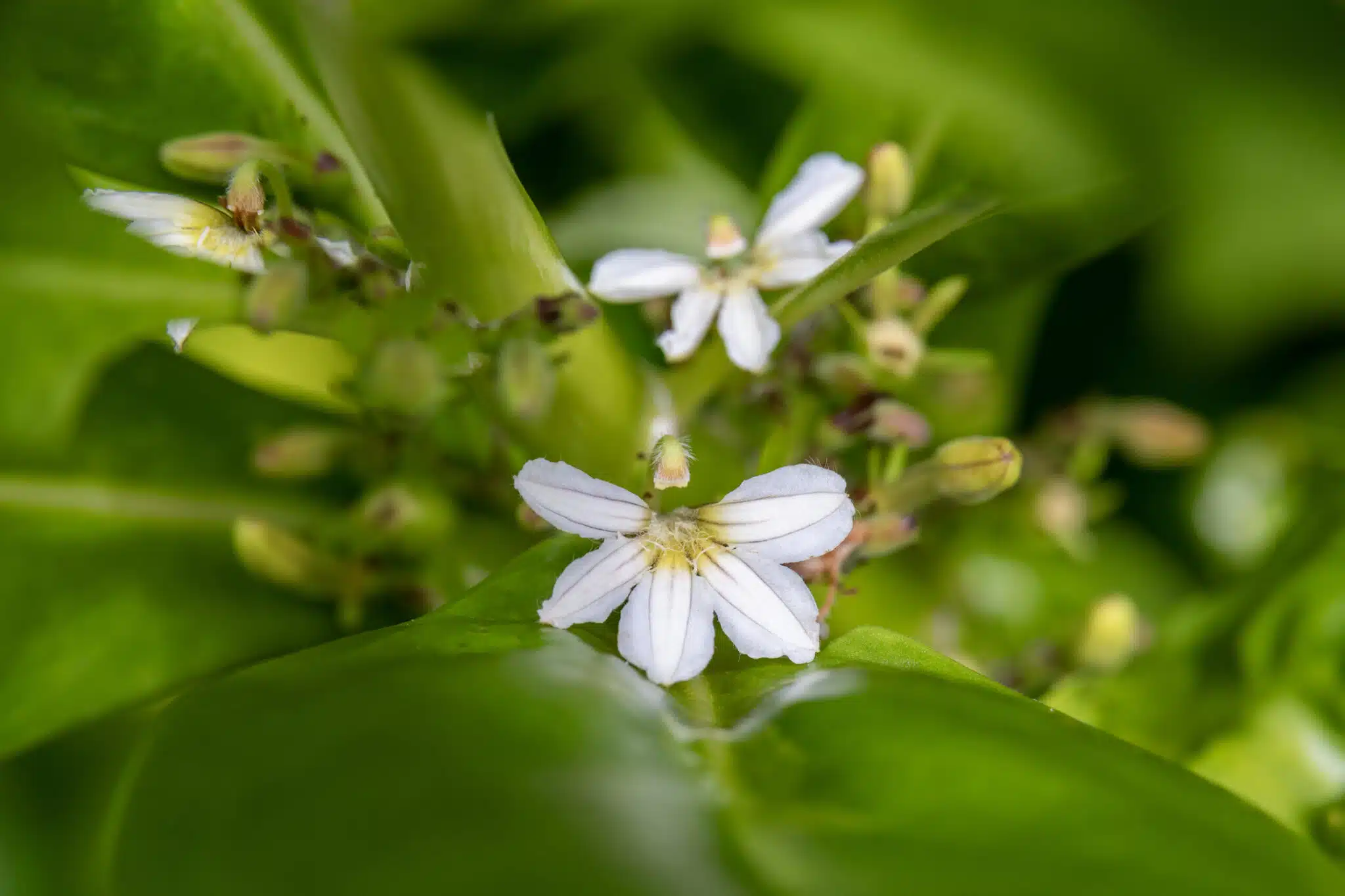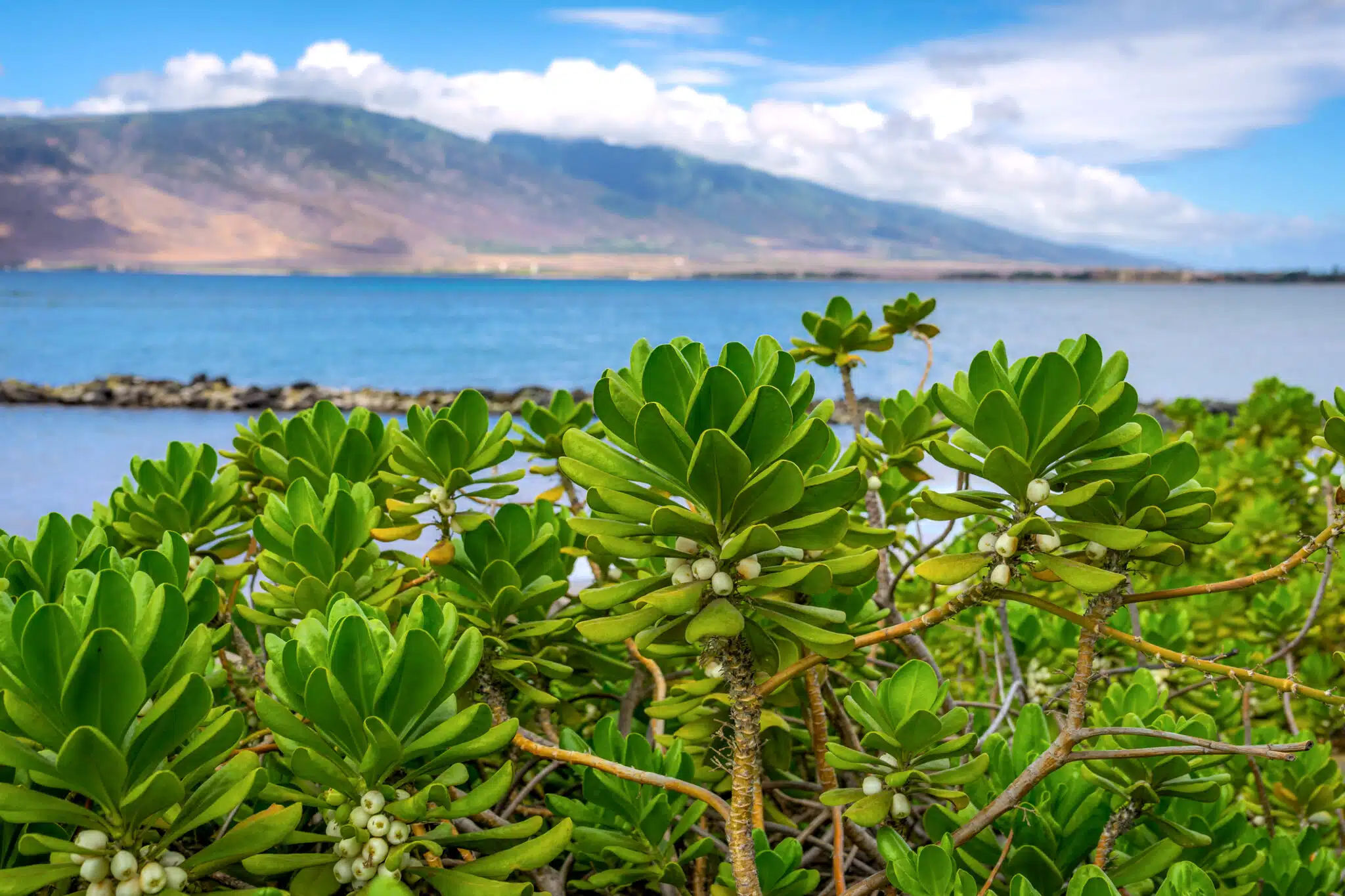Naupaka – Scaevola spp. stands out as one of the most iconic native plants in Hawaii, often seen thriving along beaches and mountainsides. Known for its distinct half-flower shape, Naupaka has sparked many Hawaiian legends, often symbolizing lovers separated by fate. This visually striking plant belongs to the Scaevola genus and showcases a lush, sprawling growth habit perfect for tropical landscapes. Locals and visitors alike appreciate its beauty, cultural importance, and adaptability to island conditions.
The two most common types of Naupaka – Scaevola spp. are the beach and mountain varieties. Beach Naupaka (Scaevola taccada) typically grows near the shoreline, with thick, waxy leaves and white to pale lavender flowers. Mountain Naupaka (Scaevola chamissoniana) prefers higher elevations, offering a more upright habit with slightly different foliage and flower forms. Despite their differing environments, both varieties share the same semi-flower shape that makes them instantly recognizable.
This hardy plant adapts well to coastal conditions, resisting wind, salt spray, and poor soil. Landscapers across tropical and subtropical regions choose Naupaka – Scaevola spp. for ground cover, erosion control, and ornamental use. It requires minimal care once established and plays a role in supporting native biodiversity. Its evergreen nature provides year-round greenery and seasonal flowering that enhances the natural appeal of gardens and public spaces.
Because of its versatility and symbolic meaning, Naupaka – Scaevola spp. continues to be a beloved addition to many tropical landscapes. Its enduring charm and cultural roots make it both functional and meaningful.

Naupaka – Scaevola spp. Details
Naupaka – Scaevola spp. features broad, fleshy leaves and a dense, sprawling habit that hugs the ground or rises upright. Its most distinctive trait is the flower, which appears to bloom only on one side, resembling a fan. Depending on the species, flower colors range from white to pale lavender, adding subtle contrast to the lush green foliage. These features make the plant instantly identifiable and visually appealing in tropical landscapes.
The plant thrives naturally in Hawaii’s coastal dunes and mountainous terrain. Beach Naupaka handles salty air, sandy soil, and wind with ease, while mountain Naupaka tolerates cooler, upland conditions. Despite these differences, both forms of Naupaka – Scaevola spp. are extremely hardy and well-adapted to challenging environments. Their success in these varied settings demonstrates their flexibility and natural resilience.
With its evergreen foliage and year-round flowering, Naupaka offers consistent visual interest. The thick leaves store moisture, helping the plant withstand drought conditions and reducing water needs. Its roots form dense mats, anchoring the plant and preventing erosion in loose soils. This makes Naupaka not only beautiful but also ecologically valuable in sensitive areas.
In tropical gardens, Naupaka – Scaevola spp. works well as ground cover, border planting, or massed in open spaces. Its low-maintenance needs and adaptability make it a favorite for sustainable landscapes. Whether near the beach or up in the hills, this plant brings texture, color, and meaning. As more gardeners seek eco-friendly solutions, Naupaka continues to be an excellent choice.
Varieties and Cultivars
Several varieties of Naupaka – Scaevola spp. thrive across tropical and subtropical climates, each offering distinct traits for different environments. The two most recognized are beach naupaka (Scaevola taccada) and mountain naupaka (Scaevola chamissoniana), both native to Hawaii. These plants differ in form, size, and foliage but share the hallmark half-flower shape. Gardeners select varieties based on growing conditions, elevation, and intended landscape design.
Beach naupaka forms dense, low mounds and grows rapidly along sandy shores and dunes. It has thick, succulent-like leaves that resist salt spray, strong wind, and heat. The flowers are often white with a slight lavender tint, blooming consistently throughout the year. This variety is commonly used for erosion control and as a windbreak in coastal areas.
Mountain naupaka grows taller and more upright, with thinner leaves and a slightly more delicate structure. It prefers higher elevations and can handle cooler temperatures with better drainage. The flowers resemble those of its coastal cousin but tend to be more spaced out along the stems. This variety suits upland landscapes and hilly garden beds.
In addition to native types, hybrid and cultivated forms of Naupaka – Scaevola spp. are now available in nurseries. These include compact forms for small gardens or containers, as well as varieties selected for enhanced flowering. Each cultivar maintains the plant’s resilience while offering more refined aesthetics. Choosing the right variety depends on space, purpose, and personal style.
Best Time to Plant
Planting Naupaka – Scaevola spp. at the right time ensures strong root development and long-term success in tropical gardens. The best time to plant is during the rainy season, when natural moisture supports early growth. In Hawaii and similar climates, this typically falls between late fall and early spring. Avoid planting during extreme heat or drought periods, as stress can hinder establishment.
Cooler months provide stable conditions for transplanting young plants or cuttings. With lower evaporation rates, the soil stays moist longer, promoting healthy root expansion. This timing reduces the need for frequent watering and protects the plant from early dehydration. It also gives Naupaka – Scaevola spp. time to adapt before the dry season arrives.
Soil temperature also plays a critical role in planting success. Warm soil, typically above 65°F, activates root systems and encourages quick recovery from transplant shock. If planting in containers, monitor soil warmth and moisture more closely. In ground plantings, mulch can help maintain steady soil temperatures throughout the season.
Planning your planting schedule around local rainfall and temperature patterns improves overall success. In windy coastal zones, try planting a day or two after a light rain, when the soil is workable but not compacted. Inland areas may offer longer planting windows due to moderated conditions. Wherever you plant, timing it right helps Naupaka – Scaevola spp. thrive from the start.
Growing Conditions
Naupaka – Scaevola spp. thrives in a range of growing conditions, making it ideal for tropical and subtropical landscapes. It prefers full sun but can tolerate partial shade, especially in upland environments. Adequate sunlight promotes fuller foliage and frequent flowering. However, in hotter inland areas, some afternoon shade can help reduce stress.
Well-draining soil is key to healthy growth, especially for mountain varieties that dislike soggy roots. Sandy or rocky soils near the coast are naturally ideal for beach naupaka. If planting inland or in clay-rich soil, consider amending with compost and sand to improve drainage. Regular watering helps new plants, but mature Naupaka – Scaevola spp. is drought-tolerant.
The plant handles salt spray, wind, and high humidity without issues. This resilience makes it a go-to for seaside gardens and exposed spaces. Mountain forms tolerate slightly cooler temperatures, while beach varieties love warm, sunny days. Both adapt well to different elevations when given proper care.
Good airflow and spacing prevent fungal problems, especially in humid zones. Avoid overcrowding, which can trap moisture and reduce flowering. When planted in suitable conditions, Naupaka – Scaevola spp. grows vigorously and resists most environmental stress. Whether near the ocean or up on a hillside, it will settle in and flourish with minimal intervention.

Planting Instructions
Planting Naupaka – Scaevola spp. starts with selecting a suitable site that offers full sun and good air circulation. Coastal varieties enjoy sandy soils and salty breezes, while upland types need slightly cooler, well-drained areas. Avoid planting in low-lying spots where water collects, as soggy roots can lead to rot. Clear the planting area of weeds and debris to reduce early competition.
Dig a hole twice as wide and just as deep as the plant’s root ball. This gives the roots room to spread out and settle comfortably. Place the plant so that the top of the root ball is level with the surrounding soil. Backfill gently, pressing the soil down lightly to eliminate air pockets and provide stability.
Water thoroughly after planting to help the soil settle and hydrate the roots. Keep the soil consistently moist for the first few weeks, especially during dry spells. Adding a two-inch layer of mulch helps retain moisture and suppress weeds. Avoid placing mulch directly against the stem to prevent rot.
Space plants according to their mature size, typically two to four feet apart for ground cover. In hedge or border plantings, closer spacing may provide a fuller look more quickly. With proper planting and initial care, Naupaka – Scaevola spp. establishes quickly and begins to thrive. Follow up with consistent care to support long-term health and beauty.
Care and Maintenance
Caring for Naupaka – Scaevola spp. is easy thanks to its natural resilience and low-maintenance needs. Once established, the plant requires little water, making it ideal for drought-prone areas. However, during dry spells or in the first few months after planting, regular watering helps maintain healthy growth. Deep watering once a week encourages strong root systems.
Fertilize lightly twice a year, once in early spring and again in mid-summer. Use a balanced, slow-release fertilizer suited for tropical plants. Over-fertilizing can lead to excessive growth and reduced flowering. Keeping nutrients balanced supports vibrant foliage and consistent blooms throughout the year.
Pruning is another important aspect of maintenance, especially in formal landscapes or small gardens. Trim lightly to shape the plant or control its spread, ideally after a flush of blooms. Remove any dead or damaged branches to promote airflow and reduce the risk of disease. For mountain varieties, occasional thinning helps maintain a natural, upright form.
Mulching helps conserve soil moisture and reduce weed growth around the base. Choose organic mulch such as bark or wood chips, applied in a thin, even layer. Monitor for pests or signs of stress, although Naupaka – Scaevola spp. rarely faces serious problems. With minimal effort, the plant stays lush, green, and thriving all year round.
Common Problems and Solutions
While Naupaka – Scaevola spp. is generally hardy, a few issues can occasionally affect its health and appearance. Yellowing leaves often result from overwatering or poor drainage, especially in heavy soils. Ensure the planting area drains well, and reduce watering if the soil stays consistently wet. Adding organic matter can help improve soil structure and prevent root rot.
Insect pests such as aphids and scale may appear, particularly during dry, warm periods. These pests feed on sap and can weaken the plant over time. Spray infested areas with water or use insecticidal soap to manage populations without harming beneficial insects. Regular inspection helps catch problems early and reduces the need for stronger treatments.
Fungal diseases are rare but may occur in overly humid or crowded conditions. Symptoms include leaf spots, wilting, or mold growth near the base. Prune affected areas and improve air circulation by spacing plants appropriately. Avoid watering from overhead, which can leave foliage damp and more susceptible to fungus.
Mechanical damage from foot traffic or lawn equipment can also impact plant health. Use edging or barriers to protect plants in high-traffic areas. In windy regions, support young plants with stakes until they establish firm roots. Most issues with Naupaka – Scaevola spp. are preventable with good care and early attention to signs of stress.
Uses and Landscaping Tips
Naupaka – Scaevola spp. offers both beauty and utility in tropical and coastal landscaping. Its dense, spreading habit makes it perfect for ground cover, especially on slopes or sandy areas prone to erosion. The plant’s robust root system holds soil in place, protecting shorelines and hillsides from runoff. Gardeners often use it as a living mulch to conserve moisture and suppress weeds naturally.
In coastal gardens, beach naupaka works well as a windbreak or informal hedge. Its tolerance for salt spray and wind makes it a favorite along walkways, beachfront properties, and dunes. The thick foliage provides privacy without the need for frequent pruning. Its year-round greenery and delicate flowers also enhance curb appeal with minimal maintenance.
Mountain varieties suit upland gardens, borders, or native plant collections. Their more upright growth pairs well with taller tropical shrubs and flowering plants. When massed together, Naupaka – Scaevola spp. creates a cohesive, textured look that blends beautifully into natural landscapes. For smaller spaces, compact cultivars can fill containers or raised beds with ease.
To highlight its form and function, combine naupaka with other drought-tolerant natives like ‘āweoweo or pōhinahina. Use stepping stones or gravel paths to define planting zones and protect roots from trampling. Whether for aesthetics or erosion control, Naupaka – Scaevola spp. adds structure and cultural richness to island-inspired designs.
Propagation Methods
Propagating Naupaka – Scaevola spp. is simple and effective, especially using stem cuttings. This method preserves the traits of the parent plant and ensures fast establishment. Choose semi-hardwood stems that are healthy and disease-free, ideally taken during warm months. Cuttings should be about six inches long, with leaves removed from the lower half.
Dip the cut end in rooting hormone to encourage faster root development. Plant the cutting in moist, well-drained soil or a sand and perlite mix. Keep the soil consistently damp but not soggy, and place the container in partial shade. Within a few weeks, roots typically form and new growth begins to emerge.
Layering is another effective propagation method, especially for ground-level branches. Simply bend a low branch to the ground, cover a section with soil, and wait for roots to develop. Once rooted, the new plant can be separated and transplanted to a new location. This technique works well for larger plants with long, trailing stems.
Propagation by seed is possible but less common, as germination can be slow and variable. Seeds should be cleaned, dried, and planted in shallow trays with light coverage. Even with slower success, this method may appeal to gardeners seeking genetic diversity. No matter the approach, Naupaka – Scaevola spp. responds well to propagation efforts with minimal effort.
Environmental Impact and Benefits
Naupaka – Scaevola spp. plays a vital role in supporting healthy ecosystems, especially in coastal and upland regions. Its roots help stabilize loose soils, preventing erosion and protecting shorelines from storm surge and runoff. This makes it a valuable ally in habitat restoration projects and sustainable landscape design. Over time, its presence can transform vulnerable areas into resilient green spaces.
The plant also supports native wildlife by offering food and shelter. Its dense foliage provides cover for insects, birds, and small reptiles, while the flowers attract pollinators like bees and butterflies. In turn, these pollinators help maintain healthy plant populations in the surrounding environment. By planting Naupaka – Scaevola spp., gardeners contribute to local biodiversity and ecological balance.
Beyond its functional role, naupaka reduces the need for chemical inputs in the landscape. Its natural resistance to pests and diseases limits the use of pesticides, while its drought tolerance minimizes water usage. This contributes to more sustainable gardening practices and reduces the environmental footprint of managed landscapes. It also supports conservation efforts by promoting native species over invasive alternatives.
From a cultural perspective, the plant holds significance in Hawaiian legends and traditions. Integrating native plants like naupaka into modern gardens preserves cultural heritage while supporting environmental goals. Whether in public parks, residential yards, or restoration sites, Naupaka – Scaevola spp. delivers ecological, aesthetic, and cultural value.
Conclusion
Naupaka – Scaevola spp. is more than just a beautiful plant, it’s a symbol of resilience, cultural heritage, and ecological harmony. Whether lining beaches or climbing upland trails, its presence brings both visual appeal and practical benefits. Landscapers, gardeners, and conservationists alike appreciate its toughness, adaptability, and year-round performance. With proper planting and care, this native treasure enhances any outdoor space.
Its unique half-flower has sparked countless stories and remains a cherished icon in Hawaiian culture. The plant’s ability to thrive in harsh conditions while supporting biodiversity highlights its ecological importance. Easy propagation and low maintenance make it accessible to gardeners of all skill levels. It truly stands out in both traditional and modern garden settings.
As environmental concerns grow, more people turn to native plants for sustainable landscaping solutions. Naupaka – Scaevola spp. meets this need beautifully, offering stability, low water usage, and habitat support. Its practical value complements its aesthetic charm, making it a smart, meaningful choice for island-style gardens.
From sandy coasts to cool mountain paths, Naupaka – Scaevola spp. continues to enrich Hawaii’s landscapes. It tells a story, supports life, and asks little in return. For those seeking beauty with purpose, this plant remains a natural favorite. Embrace its legacy and enjoy the lasting rewards of planting with intention.

